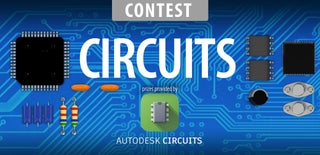Introduction: Illuminate Lightbulbs Wirelessly: DIY Slayer Exciter
Have you ever wanted to be able to control the powers of wireless electricity? Have you ever wanted to build something that can light CFL bulbs from your hand? If so, then this is the perfect instructable for you. In this instructable, I will show you how to build a device called a slayer exciter. The video below will accompany this instructable with a visual demonstration of how it works.
Lets get started!
Step 1: How It Works
A slayer exciter is basically an oscillator that has a frequency based on the LC tank circuit formed by the secondary coil and the parasitic capacitance of the top load. So now to how this circuit works. First, when power is applied to the circuit, the current flows into the base of the transistor, turning it on. When the transistor turns on, it lets power flow through the primary coil. This induces a current into the secondary coil, which flows into the base of the transistor, turning it off. When the transistor turns off, the magnetic field collapses letting current flow back into the base of the transistor from the resistor. This cycle repeats many times a second. Think of this circuit as a swing, if you push somebody an a swing, they will swing forward and backwards and oscillate. Every time you push the swing, it oscillates, but you have to push it at the right time, or it will loose energy. The circuit functions like the person pushing the swing. The transistor "pushes" the secondary coil with a magnetic field at the exact right time. This circuit oscillates at about 398 kilocycles. The constantly expanding and collapsing field creates a powerful RF field around the exciter. This causes the electrons in the CFL to bounce around and strike the phosphors in the glass, lighting the bulb. It creates high voltage because of the turn ratio of the primary to secondary coil. Now to actually building the slayer exciter.
Step 2: Materials
For this project, you will need a few different tools and materials.
You will need:
- A 600-1200 turn secondary coil (Refer to my other instructable)
- 20-26 gauge wire
- 30k Resistor
- NPN Transistor (Most NPN transistors in a TO-22 case will work)
- 1n4001 diode
- Solder
- Cardboard
- Pie tin
Optional:
- Different types of lightbulbs (Fluorescent, Xenon, Incadescent, Neon)
Step 3: Tools
For this project you will need a few tools:
- Soldering Iron
- Wire strippers
- Wire Cutters
- 18 Volt power supply
- Hot glue gun
Step 4: The Primary Coil
The first step of this project is to create the primary coil. I did this by wrapping speaker wire 4 times around a piece of cardboard rolled into a cylinder. I then glued my secondary coil to a piece of plywood. You can experiment with different amounts of wire turns to accomplish the most efficient coil.
Step 5: The Top Load
The top load of the slayer exciter is what gives the coil the parasitic capacitance needed to oscillate. I used a pie tin, but you can use almost any piece of metal without any sharp edges. Sharp edges cause unwanted discharge of electrons into the air. You then need to place the top load on top of the coil and connect it to the top wire of the secondary. You can experiment with different top load sizes to obtain optimum performance.
Step 6: Building the Circuit
The circuit is what causes the slayer exciter to oscillate. To build this, I used point to point soldering. I used this method because there are only a limited amount of components needed for this project, so it would have been a waste to solder it on a perf-board. Another option for this step is to build this on a breadboard. Make sure to connect all of the components in the same way shown on the schematic. Connect the bottom end of the secondary to the base. You also need to connect the bottom of the primary coil to the power supply, otherwise the circuit will not oscillate. After this step is done, your circuit should work.
Step 7: It Works!
Once the circuit is build, you can test the slayer exciter by plugging it in to a power supply and turning it on. It should produce a waveform on an oscilloscope, and light any fluorescent bulb nearby the secondary coil. My setup is in the picture above.
Step 8: Final Product
This coil is able to light a wide variety of lights and make a cool spark, as you can see in the pictures above. Just by holding a screwdriver to the top load, I was able to draw a spark. You can also draw a spark with your hand, the voltage does not have enough amperage to electrocute you, but the sparks can burn your skin. This project is a good demonstration of what a tesla coil can do without all the expensive parts.
Thanks for reading and good luck building!
Disclaimer: This device produces potentially harmful voltages. It also produces magnetic fields that can harm and interfere with electronic devices nearby.

Runner Up in the
Circuits Contest 2016













